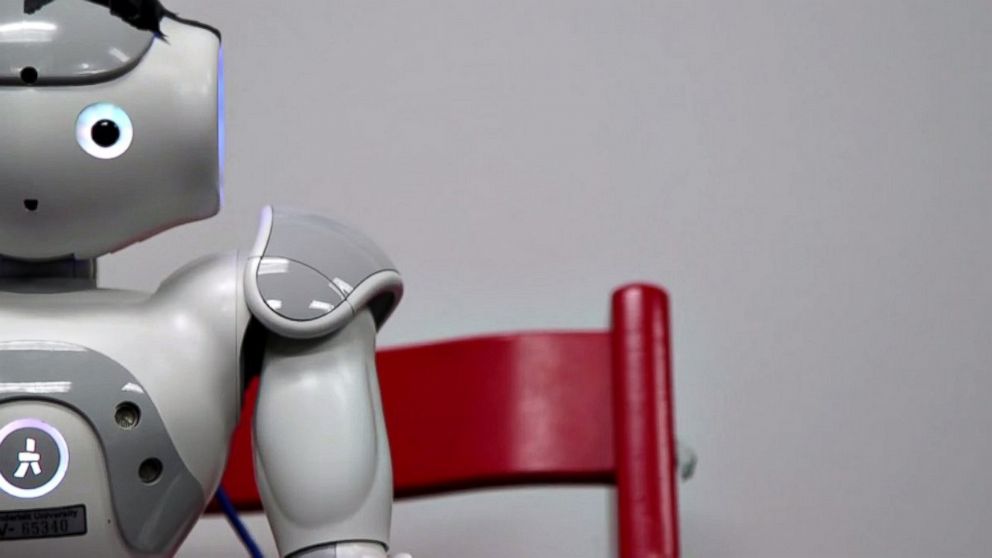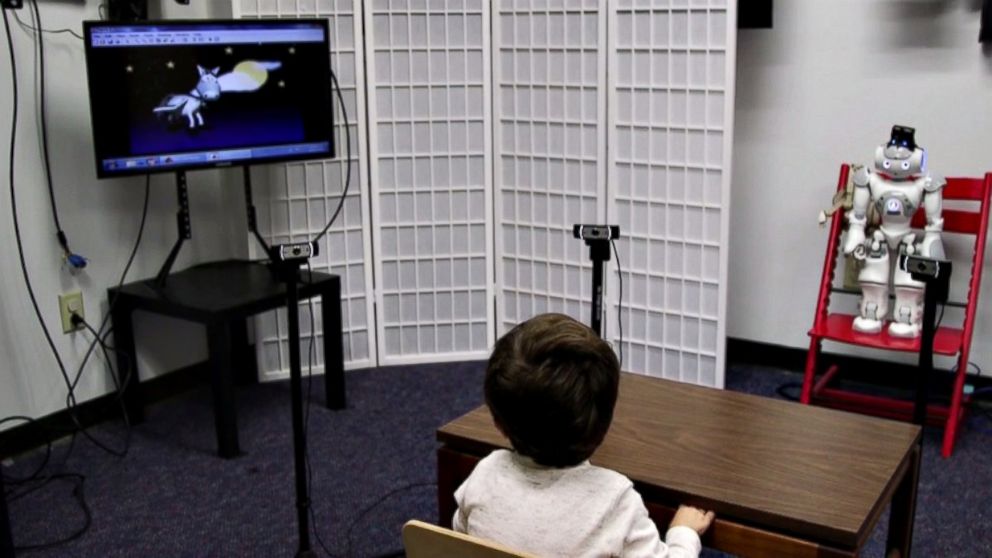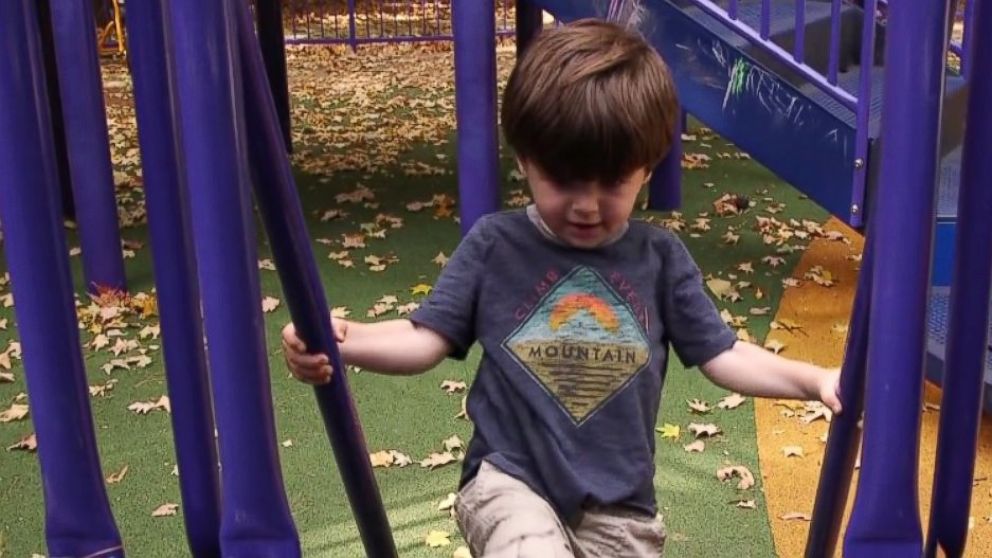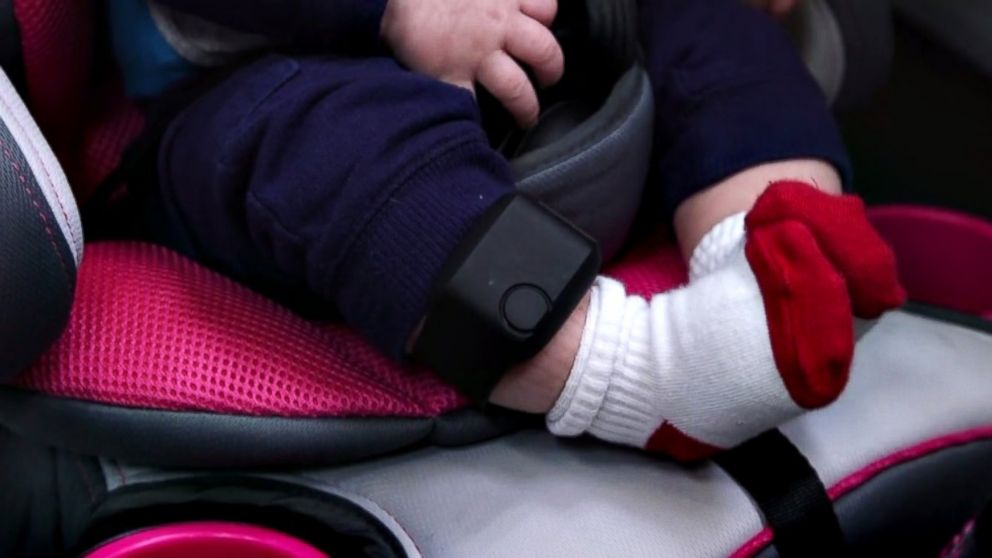Scientists use robot, other gadgets to advance autism research in young children
Vanderbilt University is testing a little robot named Russell and other devices.
— -- “Lennon, look over there!”
The command comes from a little robot named RASL, better known as Russell. It’s perched on a chair at the front of a small fluorescent-lit room. Two-year-old Lennon Landry, who was diagnosed with autism spectrum disorder (ASD) last year, is also in the room. Lennon looks to his left and sets his eyes on a TV screen. Researchers in the back then trigger a scene from "Dora the Explorer" to play.
“Good job!” the tiny robot cheers.
This intervention study, demonstrated for ABC News by researchers at Vanderbilt University in Nashville, Tennessee, is one of more than 20 studies related to autism diagnosis and treatment being conducted at the school.

The goal of the Treatment and Research Institute for Autism Spectrum Disorders is to explore how robotics and technology could help development in children diagnosed with ASD. Researchers hope the data collected from these and other studies can highlight ASD indicators in kids younger than 2, the typical age for clinical diagnosis.
In 2012 the Centers for Disease Control and Prevention estimated that 1 in 68 school-age children in the U.S. has been identified with ASD, a neurological disorder that the agency says “causes significant social, communications and behavioral challenges.” According to the CDC, ASD is about 4.5 times as common among boys as among girls.
A Vanderbilt pilot study, called Adaptive Robotic Intervention Architecture for Autism Intervention, was conducted in late 2015, with Lennon as one of six participants. Children with ASD usually struggle to share a gaze with another person, and the study was designed to address that issue.
“Use of intelligence systems and use of intelligent data analysis is allowing us to think about a critical time in development where we had a hard time approaching in previous studies,” said Zachary Warren, an associate professor of pediatrics at Vanderbilt.
Five of the six participants showed signs of improvement by the final session. While the results are promising, they are still preliminary especially with a small pool of subjects. However, the researchers hope with further study and innovation robots may help transfer social communication skills to real life.

“A child may not respond to their mother calling their name but may automatically respond to a robot action or a piece of technology,” Warren explained. “If we can use that technology to shift how that child responds, then we may have a very valuable system to that child, that family and maybe for autism intervention.”
Lennon is a regular participant in multivisit intervention studies with the university and is enrolled in a special ASD preschool there. He’s currently nonverbal and mostly communicates through palm gestures.
“It’s scary. It’s obviously scary,” Lennon’s mom, Valerie Landry, said about learning of her son’s diagnosis.
“Because at one point, Lennon was talking. He was all over us. He was following us everywhere, wanting to know what we were doing at all times. He was on track. And then … we saw a major regression,” she said. “We went through the denial stage after [Lennon’s] diagnosis, but then we went into proactive stage — ‘What can we do to help our children?’”

But even with all of Russell the robot’s assumed potential, other researchers in the autism field urge caution when pinning ASD intervention skills on androids.
“If you think about it, it’s not real life. We don’t interact with robots on a regular basis. We interact with people and deal with the unpredictability of the people,” said Max Wiznitzer, a pediatric neurologist with University Hospitals Rainbow Babies and Children’s Hospital in Cleveland.
“It’s still a clinical diagnosis,” he said, “which means with all of the technology that we might be using, the bottom line is you need to meet the clinical criteria.”
Warren said the primary focus for testing robots is to push boundaries, not replace old methods. “They’re really designed to help take us into areas that we’re not there yet,” he said.

Across campus, another team of researchers are doing just that — looking to see if indicators of ASD can be identified in infants less than 1 year old.
“We have created a study where we give stimuli on the audiovisual and on the tactile stimuli … like a mother’s touch,” said Nilanjan Sarkar, a professor of mechanical engineering at Vanderbilt. “And there is research that shows that there is a possibility with children who develop autism later, [they] may respond differently.”
In the department’s How Babies Respond to Talking and Touch study, demonstrated for ABC News, 4-month-old Daniel Bailey was placed in a car seat, hooked up to an E4 wristband sensor and played a soothing video of a woman speaking in a gentle baby voice. As he sat there, his arm was lightly stroked by a soft makeup brush on a pulley, powered by a tiny motor. A robot logged his eye movement and other physical reactions.

The demonstration went on for about 10 minutes, and Daniel didn’t cry once; he just watched, gurgled and kicked his tiny legs.
“Acceptability and tolerability are big things, because we did not know whether a child that age would go through the process,” said Sarkar. “[The study] is ongoing right now, but [of the] eight children [in the study], none of them dropped out.”
Researchers plan on following Daniel and the other seven children for the next few years to see if any of them are eventually diagnosed with ASD. They hope that with the data recorded now, they will be able to detect any differences between those who develop ASD and those who don’t.
“The overall goal is to develop and deploy meaningful accelerant technologies,” Warren said of both projects. “Tools that accelerate diagnosis, tools that accelerate treatment, tools that accelerate fundamental learning for children with autism.”
Both robotic pilot studies received most of their funding from the National Science Foundation, the National Institute of Mental Health and Vanderbilt University. There was no proprietary funding, and both studies are not expected to go to clinical applications in the near future.




